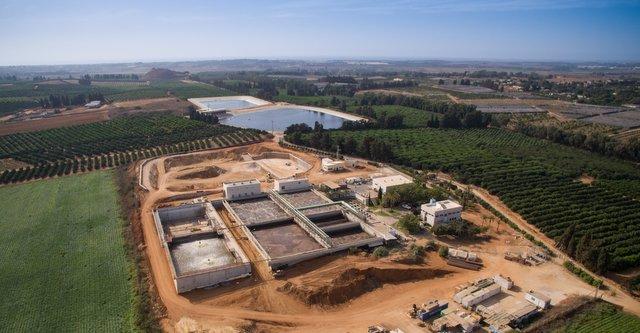WASTEWATER TREATMENT CENTER AND RECLAMATION PLANT
The wastewater treatment compound in Raanana was established in 1998-1999. The center is situated in the area of the orchards at the north section of the city and commenced full operation in February 1999. In actuality, the wastewater plant literally deals with recycling: collecting the raw material, decomposing and treating it and transforming it into different raw materials, all of which can be returned to nature. The Center serves as a collection point for all of Raanana’s sewage, it treats the sewage using the SBR method (sequencing batch by reactor) which is a sophisticated continuous activated sludge process.
The sewage that enters the plant undergoes a process of decomposition using bacteria, and is transformed into two byproducts:
- Treated wastewater – purified water fit for irrigation.
- Sludge – transferred for the production of compost or agricultural fertilizer at authorized facilities.
The Center produces very high quality treated wastewater, known as “unlimited irrigation” – of tertiary quality. In the activated sludge process, bacteria pellets are suspended, which consume the organic material as food in order to grow. The process takes place under optimal conditions, while maintaining the levels of oxygen, pH, and the concentration of the sludge pellets and other parameters that enable the optimal decomposition and consumption of the degradable material in the wastewater.
At the end of the decomposition/consumption of the organic material, the sludge pellets are separated from the water and the wastewater is transformed into purified treated wastewater, which is water that contains a very low concentration of pollutants. In order to maintain the optimal growth and decomposition conditions, only a certain level of sludge pellets is kept in the system. The surplus sludge is removed for further treatment.
During the activated sludge process, each stage of the treatment is executed in a separate basin; however, in the SBR method, all the recycling stages take place in one treatment basin.
In 2008, the treatment center treated 14,000 cubic meters of water (one cubic meter = 1,000 liters) per day; however, in 2010, this amount dropped to only 12,000 cubic meters, due to Raanana’s residents ‘awareness of the water crisis and the need to conserve water. Consequently, each year, 4.3 million cubic meters of water are treated and transformed into purified treated wastewater, and about 5,000 tons of sludge, which are transformed into compost – artificial fertilizer.
In the summer of 2010, 60% of the center’s treated wastewater was used for agricultural irrigation in the Raanana region as part of the Mei Raanana Water Company Wastewater Reclamation Plant, and the remainder was transferred to the Poleg River.
In March 2011, the Raanana Wastewater Reclamation Plant was connected to the regional treatment plant in the north – the Sharon Beach Plant - and starting in winter of 2011, the surplus treated wastewater from Raanana has been transferred to the Sharon Beach Plant and is used for agricultural irrigation. This combination of wastewater treatment plants enables approximately 80% recycling of Raanana’s treated wastewater.
In 2012-2013, an upgrade of the Wastewater Plant was executed that included the expansion of the plant to receive larger quantities of wastewater by the year 2030 – and an additional improvement in its quality to reach a quality level known “Flowing into the River”. As part of the center’s expansion, a considerable emphasis will be placed on energy efficiency and backup for coping with malfunctions.
How does wastewater treatment center operate?
The purification process begins with a physical process, in which the sand and gravel (solid waste) are removed. The liquids are transferred to three basins for biological treatment of the bacteria, which enables the continuous inflow of wastewater and the batch treatment of each of the three basins alternately, and a fourth basin for sludge.
The wastewater produced undergoes disinfection and is transferred to the eastern reservoir of the Mei Raanana Water Company Reclamation Plant. From the eastern reservoir, the wastewater is transferred to the western reservoir through a filtering plant that upgrades the quality to a tertiary level and from the western reservoir, it is transferred for irrigation.
All the sludge is squeezed through a belt filter and after this filtering process, it is transferred to a compost production factory and used for agricultural fertilizer for authorized crops.
The Center is operated automatically by a computerized control system and the Mei Raanana Water Company team. The main equipment components include back-up systems that enable the proper operation even in the case of malfunctions in the equipment and minimize damage to the environment.
The Mei Raanana Wastewater Treatment Center, a sophisticated state-of-the-art biotechnological plant worth tens of millions of shekels, is closely supervised by the Mei Raanana Water Company’s team, in order to immediately repair malfunctions and prevent damage to the environment. The treatment process that uses bacteria is sensitive to changes in the quality of the incoming wastewater; and consequently, it is very important to prevent the entry of harmful materials into the sewage that may enter the treatment center and influence the bacteria and the environment. Consequently, it is important to avoid discarding materials into the wastewater such as oil, fuel, paint, cleaning materials, antibiotics, hormones, pesticides, or any other toxic material.

